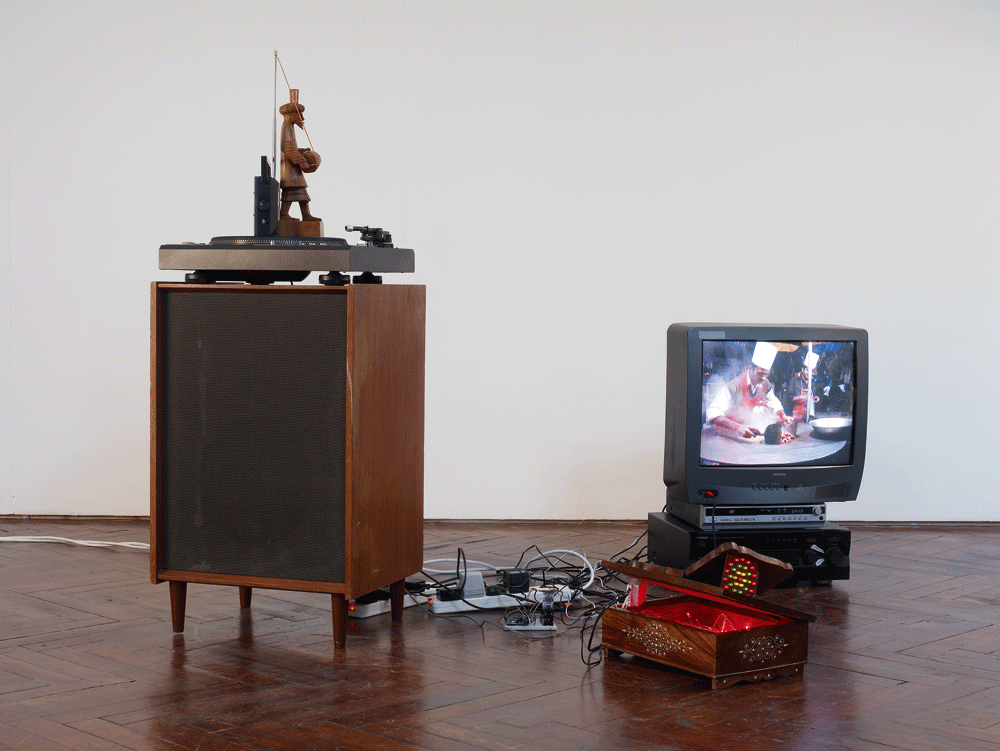Haroon Mirza
Music, tradition and Islam; organized noise, film and instability
Music, tradition and Islam; organized noise, film and instability

Haroon Mirza’s installations are often heard before they are seen, filling corridors and adjacent spaces with an industrious fog of electronic sound. But these aural titbits offer little in the way of a preview of the sculptural configurations that lie ahead. The Sheffield-based British artist’s works often resemble dislocated domestic environments assembled from an eclectic inventory of objects: found bits of furniture and electrical appliances, outmoded musical equipment, lamps and television sets, frequently interspersed with works by other artists, adding other voices to the organized cacophony. Each given a job to do, the functionality of these elements is often playfully challenged and redirected in the service of generating sound or other performative actions: the buzz of static interference produced by the antenna of a portable radio passing a light bulb that is rotating on a record player; the discordant sounds of an electronic keyboard being played by a jet of water bubbling up inside a metal dustbin and hitting its exposed circuitry. Despite first appearances, an insistent compositional order underpins each of Mirza’s ensembles, an order which explores moments when social or cultural experience becomes aligned (or misaligned) with music and historical aural traditions.
Take works such as Adhãn or Taka Tak (both 2008), which stem from Mirza’s interest in the uneasy role music plays in Islamic faith, a subject he researched during an extended trip to Pakistan in 2008. While being seen by some Muslims as a sinful indulgence, music is fundamental to Muslims’ engagement with the Qur’an, most strikingly in the mournful ‘Adhãn’, the Islamic call to prayer recited by a muezzin, which punctuates daily life five times a day. Mirza’s Adhãn comprises a number of pieces of furniture animated by sound, video and light elements including a sample of the opening bars of a 1971 BBC concert by Cat Stevens (six years before his conversion and rebirth as Yusuf Islam) which acts as an acoustic trigger for a flashing desk lamp, and a video of a cellist projected onto the side of an upturned speaker. Taka Tak takes its name from a Pakistani street dish made from goat innards, which in turn takes its name from the mesmerizingly rhythmic sound of the chef’s metal spatulas mincing the meat. A simple documentary video of one of these chefs sits alongside a wooden sculpture of a Sufi, spinning on a turntable; two Qur’an stands contain sound and light sources which pulsate in time to the video’s soundtrack. As much as Mirza is interested in disassembling the ideological parameters of Islamic faith in these works, the sonic and visual landscapes of Taka Tak and Adhãn, which wilfully shift between moments of cohesion and dissolution, examine the power structures of organized religion in general, which offer a semblance of control over the uncontrollable.

Time is pulled in several directions at once in Mirza’s work. While each object he uses generates a seemingly infinite field of sound, they also serve to slow things down; the mid-century look of the furniture encourages a retrospective glance; the intricate mechanisms constructed to produce the sounds work to stretch the space between object and sound. Mirza’s use of analogue music devices – such as turntables, domestic radios and oversized speakers which verge on furniture – poses a challenge to the stealth efficiency of digital technology. His insistent use of the turntable in works such as Paradise Loft (2010), which incorporates a work he commissioned from artist Giles Round (MW, 2009) and sampled film footage of musician Arthur Russell, acts as a totem for the birth of 1970s club culture (the title references The Paradise Garage and The Loft, New York nightclubs frequented by Russell). This scene emerged out of both the black and gay communities and introduced the technique of ‘beatmixing’, by which legendary DJs like Larry Levan and Francis Grasso created ‘endless’ disco tracks by synchronizing the beats of sequential records.
Mirza employs a comparable technique to bind independent formal and aural elements, with the introduction of works by other artists adding further interference to that which already crackles through his installations. The critical potential of transformation suggested by Duchamp in his oft-cited adage of using a Rembrandt as an ironing board is harnessed by Mirza in installations such as An_Infinato (2009) which convenes Guy Sherwin’s 16mm film Cycles (1972/7) and 18 minutes’ worth of unused footage from Jeremy Deller’s film 2003 film Memory Bucket (acquired legitimately while Mirza was Deller’s studio assistant) alongside Mirza’s own aforementioned keyboard-played-by-water assemblage in a triangulated conversation. Mirza confronts the structuralist regularity of Sherwin’s stroboscopic film and pulsating soundtrack, made by punching holes into the frames and audio track of the film, with the intense amorphous sounds of one and a half million bats in Deller’s video building a stochastic soundscape that might best be described in composer Edgard Varèse’s words as ‘organized noise’.
An interest in the taxonomic shift between sound and noise resonates throughout Mirza’s work – the space in-between is the subject of his ‘Sound Spill’ research project (2009–ongoing) focusing on the incidental fields of noise created by sound spill in exhibitions (this was first manifested as a group show, curated by Mirza and Thom O’Nions, which included Nina Canell, Torsten Lauschmann, Guy Sherwin and Richard Sides). If noise, and noise music, can be defined as an inherently critical genre, defying categorization and challenging the usual means of consumption, Mirza’s noise-producing machines deploy this instability against the autonomy of the art object, objects which in Mirza’s hands operate on the brink of collapse.























